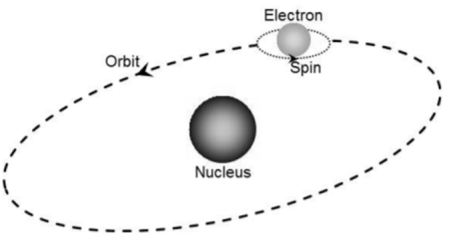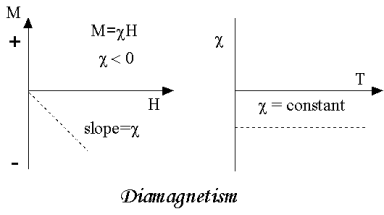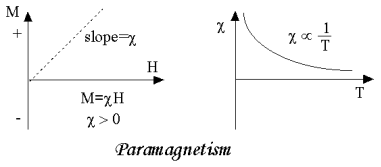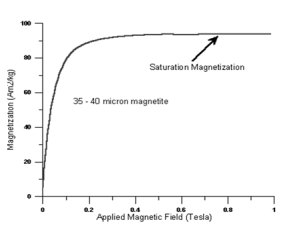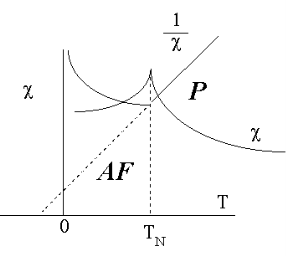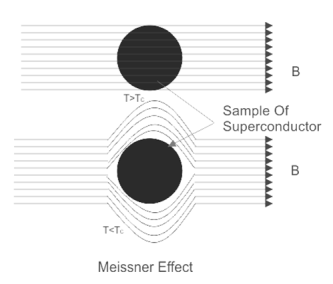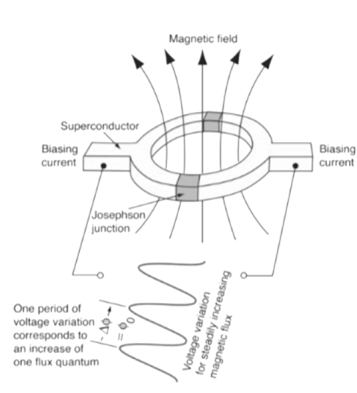Unit 5
Magnetism and Superconductivity
- Consider a simple electromagnet which can be produced by wrapping copper wire into the form of a coil and connecting the wire to a battery.
- A magnetic field is created in the coil but it remains there only while electricity flows through the wire.
- The field created by the magnet is associated with the motions and interactions of its electrons, the minute charged particles which orbit the nucleus of each atom.
- Therefore, electricity is the movement of electrons, whether in a wire or in an atom, so each atom represents a tiny permanent magnet in its own right.
- The circulating electron produces its own orbital magnetic moment, measured in Bohr magnetons (µB), and there is also a spin magnetic moment associated with it due to the electron itself spinning, like the earth, on its own axis as shown in figure.
- In most materials there are resultant magnetic moments, due to the electrons being grouped in pairs causing the magnetic moment to be cancelled by its neighbor.
|
Fig 1. The orbit of a spinning electron about the nucleus of an atom.
Magnetism originates from the spin and orbital magnetic moment of an electron.
The orbital motion of an electron around the nucleus is analogous to the current in a loop of wire.
The magnetic moment of a current carrying conductor is given by
µ= I.A
I is the current in Amp
A = A is the area in m2.
Orbital magnetic moment
The magnetic moment of an electron in orbit is given by
 ----------------------(1)
----------------------(1)
where r = radius of the orbit
e = charge
v = velocity.
The angular momentum of an electron must be an integral multiple of Planck’s const.
mvr=nh/2π ____________________ (2)
where
m is the mass and
h is the Planck's const.
If the electron revolves in the first orbit then n=1
Therefore, orbital magnetic moment of an electron is given by from (1) and (2)
µ =neh/4πm -- (3)
which is known as Bohr magneton, the smallest possible orbital magnetic moment
The magnetic behavior of materials is classified into :
- Diamagnetism
- Para magnetism
- Ferromagnetism
- Ferrimagnetism
- Anti-ferromagnetism
Diamagnetism is the fundamental property of all matter. These substances are composed of atoms and have no net magnetic moments, which meansall the orbital shells are filled and there are no unpaired electrons. But when exposed to a field, a negative magnetization is produced and therefore the susceptibility is negative.
If we plot M vs H, we see:
|
Figure 2. Diamagnetism
Para magnetism
In these materials, some of the atoms or ions have a net magnetic moment because of unpaired electrons in partially filled orbitals.
Iron is one of the most important atoms with unpaired electrons. However, individual magnetic moments do not interact magnetically, as in diamagnetism, the magnetization is zero when the field is removed.
However, in the presence of a field, at present there is partial alignment of the atomic magnetic moments in the direction of the field, which results in a net positive magnetization and susceptibility.
|
Figure 3.
In addition to the efficiency of the field,when themoments are aligned it is opposed by the randomizing effects of temperature. This results in a temperature dependent susceptibility, known as Curie Law.
- Ferromagnetism
- In these materials the atomic moments exhibit strong interactions.
- The interactions are produced by electronic exchange forces which resultin parallel or antiparallel alignment of atomic moments.
- The exchange of force in quantum mechanical phenomenon is due to the relative orientation of the spins of two electron.
- Ferromagnetic materials exhibit parallel alignment of moments resulting in large net magnetization even in the absence of magnetic field.
|
- The typical ferromagnetic materials are elementslike Fe, Ni, and Co and many of their alloys
- The two distinct characteristics of ferromagnetic materials are :
- Spontaneous magnetization
- Existence of magnetic ordering temperature
Spontaneous Magnetization
- The spontaneous magnetization can be defined as the net magnetization that exists inside a uniformly magnetized microscopic volume in the absence of a field.
- The saturation magnetization occurs when maximum induced magnetic moment can be obtained in a magnetic field (Hsat).
- Beyond this there is no magnetization.
|
Figure 5. Saturation Magnetism.
|
If A and B sublattice moments are exactly equal but opposite then net moment is zero. This type of magnetic ordering is called antiferromagnetism.
|
Figure 7. Behaviour
The hint to antiferromagnetic is the behaviour of susceptibility above a critical temperature, called the Néel temperature (TN).
Above TN, the susceptibility obeys the Curie-Weiss law for paramagnets but with a negative intercept indicating negative exchange interactions.
- Transformer cores
- The features of transformers are primary, secondary and tertiary windings where flux is produced between these windings.
- The magnetic cores serve as the pathway of the flux. These cores are magnetic materials with high magnetic permeability that can be used to guide magnetic fields in transformers and other electrical or magnetic devices.
- There are a various materials that can be used to manufacture these magnetic cores.
- Made of ferromagnetic metals or compounds.
o Magnetic storage
Magnetic storage is one of the most common and enduring form of removable-storage technology.
It is coated with iron oxide where theoxide is ferromagneticmaterial. This means that if you expose it to a magnetic field it is permanently magnetized.
The media is called a disk or a cartridge. The drive uses a motor to rotate the media at a high speed, and it readsthe stored information using small devices called heads.
Here each head has a tiny electromagnet which consists of an iron core wrapped with wire. The electromagnet applies a magnetic flux to the oxide on the media, and the oxide permanently "remembers" the flux it sees.
During writing, the data signal is sent through the coil of wire to create a magnetic field in the core. At the gap, the magnetic flux forms a fringe pattern. This pattern bridges the gap, and the flux magnetizes the oxide on the media.
When the data is read by the drive, the read head pulls varying magnetic field across the gap, varying magnetic field is created in the core and therefore signalis generated in the coil. This signal is then sent to the computer as binary data.
Magneto-optical recording
- Magneto-optical recording writes or reads optically. During writing, the magnetic medium is heated locally by a laser, which induces a rapid decrease of coercive field. Then, a small magnetic field can be used to switch the magnetization
- The reading process is based on magneto-optical Kerr effect. The magnetic medium is typically amorphous R-Fe-Co thin film.
- MO or magneto-optical recording is a method of storing and retrieving data using a laser and a magnet.
- The drive laser heats the magnetic surface to sufficienttemperature which allows the polarization of the disk to be modified with a magnet for more precisely written data. When data needs to be read from the disk a laser of less intensity is used.
Superconductivity was discovered by Dutch Physicist Heike Kamerlingh Onnes in 1911 in Leiden.
Some materials when cooled below a certain temperature their resistivity get abolished meaning, they exhibit infinite conductivity.
The temperature at which the metals change from normal conducting state to superconducting state, is called critical temperature/transition temperature.
An example of superconductors, is Mercury. It becomes superconductor at 4k. In superconducting state, the materials expel the magnetic field. A transition curve for mercury is shown in figure below-
|
Figure 8. Superconductivity
- Properties of superconductors:
Zero electrical resistance:
- Zero electrical resistance: It refers to the condition of superconductivity where the resistance is zero.
- The material conducts current perfectly at zero resistance. In super conductor the electrical resistance is zero though it has flaws and vibrations.
Critical magnetic field:
Critical magnetic field refers to the condition where the magnetic field is required to convert from superconductor to conductor.
Persistent Current
- Suppose a ring made of superconductor is placed in a magnetic field above its critical temperature. After some time cool the ring of superconductor below its critical temperature. If the magnetic field is removed,current is induced in ring due to its self-inductance.
- In Lenz law the direction of this induced current is such that it opposes the change in flux passing through the ring.
- As the ring is in superconducting state that is zero resistance, the current induced in ring will continue to flow, and this current is called the persistent current. Thepersistent current produces magnetic flux making the magnetic flux passing through the ring constant.
Meissner Effect (Expulsion of Magnetic Field)
The Superconductor, when cooled below the critical temperature Tc, it expels the magnetic field and doesn’t allow the magnetic field to penetrate inside . This phenomenon in superconductors is called Meissner effect. The Meissner effect is shown in figure below-
|
Figure 9. Meissner effect
There are two types of superconductors commonly known as Type I and Type II superconductors.
Type I superconductors are soft superconductors. They are usually pure specimens of some elements namely metals. In technical applications they are less useful.
Type II superconductors are hard superconductors. They are usually alloys of metals with high value of resistivity in normal state. These are usefulwhen compared to Type I materials.
Type I | Type II |
Soft superconductors are those which can tolerate impurities without affecting the superconducting properties | Hard superconductors are those which cannot tolerate impurities that is impurity affects the superconducting properties |
One critical field exists | Two critical field exists. |
Critical field value is very low | Critical field value is high |
Exhibits perfect and complete Meissner effect | Does not exhibit perfect and complete effect |
Current flows through the surface | Current flows throughout the material |
Low temperature superconductor LTS refers to the Nb-based alloy and A15
In order to be super conducting its temperature must be cooled below the temperature for it to become superconducting.
For LTS superconductors the temperature is usually below 20 K (-253 °C).
Nb-47wt.%Ti alloy has become the dominant commercial superconductor because it can be economically manufactured in a ductile form .
High-temperature superconductivity
High-temperature superconductorsbehave as superconductors atunusually high temperatures. The first high-Tcsuperconductor was discovered in 1986 by Karl Muller and Johannes Bednorz. The “ordinary” or metallic superconductors usually have transition temperatures.
HTS observed transition in temperatures as high as 138 K (−135 °C). However, several iron-based compounds such as iron pnictidesare now known to be superconducting at high temperatures.
The applications for HTS have been
- Low thermal loss current leads for LTS devices (low thermal conductivity),
- RF and microwave filters increasingly in specialist scientific magnets, particularly where size and electricity consumption are critical .
B.D. Josephson analyzed that a junction is formed between two closely spaced superconductors, separated by an insulating barrier. If the insulating barrier is thick, the electron pairs cannot pass through.
However if the layer is thin there is a probability for electron pairs to tunnel. This effect is known as 'Josephson tunneling'.
Josephson junction finds its applications in analog and digital electronics, such as SQUID detectors, oscillators, mixers and amplifiers.
|
Figure10. Two superconductors separated by a thin insulator
Suppose we have two superconductors connected by a thin layer of insulating material as shown in figure. We define Ψ1 and Ψ2 as the quantum mechanical wavefunction of the superconducting state in the left and the right superconductor. The dynamics of the two wavefunctions are then determined by the following coupled Schrödinger equations:
|
where K is constant representing the coupling across the barrier. µ1, µ2 are the lowest energy states on either side. The wavefunctions can be written as
|
where n1, n2 are the density of Cooper pairs and θ are the phases. Substituting equation (2) into equation (1) gives
|
The time derivative of the density of Cooper pairs describes a charge transport therefore I = ∂n 1 /∂t . If a voltage V is applied between the junctions the energy levels will shift that is µ 2 −µ1 = 2eV . Let I 0 = 2 K n 1n 2 / h and δ = θ1 – θ2 then
|
Equations (5) and (6) provide the main results of Josephson junction theory. The current I is called a Josephson current or a supercurrent. This strongly predicts non-linear current-voltage behavior.
From equation (5,6) it is clear that a DC current can be drawn through the junction without any voltage drop, as long as the DC current is smaller than I0.
The phase difference will adjust according to equation (5).
The AC Josephson effect: If we apply a DC voltage V0 to the junction then from eq(5) and (6) we obtain
|
where 2e/h = 483.6 GHz/mV.
A SQUID is a device used precisely to measure extremely small magnetic field changes. It is based on the theoretical works of Josephson.
The different types of SQUID are:
- SQUIDs, which consist of a superconducting ring interrupted at a point (rf-SQUID)
- Two points (dc-SQUID) by a normally conducting or electrically insulating material.
The SQUID function is based on the effect of flux quantization in superconducting rings and the Josephson effect. The magnetic flux flows through the superconducting ring whose size is an integral multiple of the elementary magnetic flux quantum Φ0 = 2.07 × 10-15Vs.
However, if the external magnetic field changes, an electric current in the circuit is excited in the ring which is large enough to increase or reduce the magnetic flux in the superconducting ring to the nearest multiple of the flux quantum.
In the superconducting ring consider dc-SQUID here two Josephson contacts are introduced, whereby the ring is divided into two parts.
The two ring parts are now contacted and a direct current is passed through the SQUID. This results in a measurable electrical voltage at the SQUID, which is dependent on the externally applied direct current and on the compensation currents.
The external flux is further increased tillit is greater than half the magnetic flux quantum, then SQUID prefers to increase to Φ0. This is because only integer multiples of flux quantum can flow in this loop which leads to a change in direction of the screening current.
This happens every time the flux through the superconducting loop is increased by half of Φ0. Therefore, the critical current oscillates as a function of the applied flux.
The measured value is the voltage at the device as shown in figure The evaluation of the voltage-flux curve helps us to resolve magnetic field changes in the order of 10 -18 T. This makes the SQUID a successful device.
|
Figure 11. SQUID
- Applications of Squid
- Bio magnetic measurements
- Geophysical measurements
- Voltage and current measurements
- Interference and noise
- Application of Super Conductor
- Magnetic energy is stored in large superconductors and drawn when required to counter the voltage fluctuations during peak loading.
- The superconductors are used to perform logic and storage functions in computers.
- The superconductor material can be suspended in air against repulsive force from permanent magnet. The levitation can be used in transportation.
- Because there is no heat loss in superconductors, power can be transmitted through the superconducting cables.
Superconducting materials used for power cables enable transmission of power over very long distances.
Reference:
1. Engineering Physics-Avadhanulu, Kshirsagar, S. Chand Publications
2. A textbook of optics- N Subrahmanyam and BriLal , S. Chand Publications
3. Engineering Physics- Gaur, Gupta, Dhanpat Rai and Sons Publications
